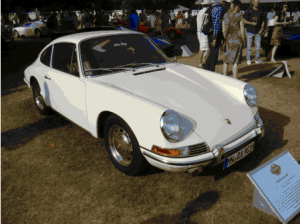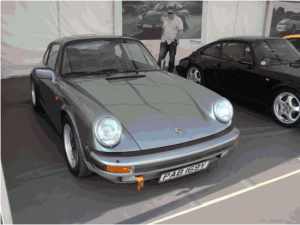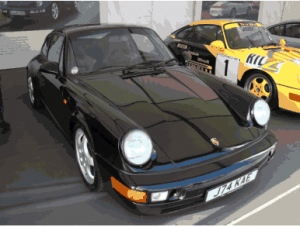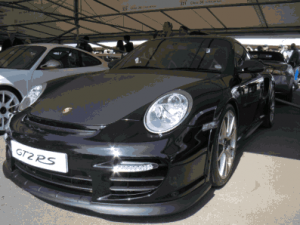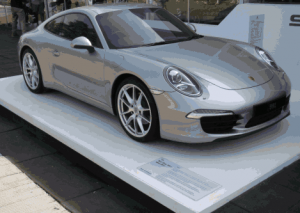Goodwood Festival of speed witnessed this year the fiftieth celebration of the Porsche 911 sports car. Love them or hate them you have to admire anything that lasts 50 years, and when you think that Ferdinand Porsche was on a roll having previously created the Beetle car and then the model 365 from which this model was derived, the evolution of the classic design is amazing in many ways not only for its longevity.
Publically debuted at the 1963 Frankfurt Motor show the original version (known as the model 901),was built in small numbers until the name got revised as Peugeot got out of their prams about the number and so 82 cars got built with the name. Subsequently named the 911, the current all ingredients were in place. Stylish bodywork, engine slung out the back, with a 2+2 seating interior which let’s be frank, never served the rear seats well. The Boxer engine was a 2.0litre flat six version producing about 128hp, which was a figure that would only rise with evolution of the breed.
The equally as famous Fuchs alloys didn’t appear until 1965 by which stage the engine development had started in earnest reached the dizzy heights of 158hp in the 911S model which was sold in 1966. Later in 1967 the famous Targa topped model appeared with a completely removable roof section which immediately proved popular. A small extension of the car’s wheelbase tried to cure some of its evil tail happy handling characteristics in the B spec version but it wasn’t until 1972 that the next serious development came in the 1972-73 model with the introduction of the 2.4 litre engine which besides its bigger bore and stroke had the novel Bosch mechanical fuel injection. A small discrete front spoiler also tried to assist the handling as various other models appeared notably the 911E model. An H pattern gearbox also replaced the dogleg that had been used in earlier models.
1974 saw the introduction of the Classic Carrere model with the legendary lightweight RS version appearing for racing .Engine size had grown now to 2.7 litres and 210hp was found in a chassis some 100kg lighter(thinner steel and thinner glass was fitted). A classy 2.8 litre RS also produced serious power in the region of 300hp with 49 of these being made. Turbo cars also appeared around this time used initially for racing, these brutal cars with the Whale Tail rear spoiler and significantly wider rear wheels appearing set a trend in the design of the car.
Next significant change was to the look of the cars with big bumpers added in deference to the US market where the laws required them. Engine sizes were on the rise again with 3.0 models becoming more commonplace. The introduction of the SC model also featured K jetronic injection and finally horsepower broke through the 208 mark.
The model shown above is the 78-83 SC which also coincided with the introduction of the 5 speed gearbox.
Next derivative of the breed came with the model number 964. This ran from 1988 until 1993 and featured more modernisation of the brand. ABS brakes, power steering and a Cd value of 0.32 showed that Porsche was seriously tackling the aerodynamic performance of their cars.
Now I’m not going to try and pretend that I know all the inns and outs of 911’s but over the years the engine sizes rose as did the power ending in the ultimate version of the air-cooled engine the 993 version. Last of the pure 911’s the 993(from 1994-1997), also showed the trend on the body evolution with wind tunnels now playing a part.
Integral bumpers, more shapely headlights and a pop up rear spoiler which activated above 50 mph, this car was designed by a brit called Tony Hatter. Engine sizes were around 3.6-3.8 litres and the 4×4 version also arrived. At this stage with emissions being significant Porsche recognised that the air cooled cars had run their time and replaced the 993 model with newer water cooled 996 model and whilst initially purists hated the new model it has stood the test of time and still pushes out significant power.
The 996 model ran from 1998-2004 and is easily distinguished by the new flat fronted headlight units which now incorporate the indicators.
This was the first brand new bodyshell in the range and featured a lot of parts that were common with its cheaper Boxster stablemate. The drag factor now measured 0.30 and exotic brake materials became commonplace. The flipping rear spoiler now popped out at 75mph or at the flick of a switch for those of a posing persuasion. Exotic versions included the new GT3 which was a stripped out back to basics race version for the road. Top speeds had now reached the dizzy heights of 189mph and turbo versions continued the trend to achieve amazing power outputs from the ever enlarging engine sizes.
In 2005 the next model the 997 arrived, lasting until 2011. This featured headlights that reverted to the previous position but with xenon bulbs and a new Porsche derived suspension system freshened the model range. The ever chased co efficient of drag had reached 0.28 and significantly there was a new style of wheel employed called “lobster Fork “style
Computer aided design evolved the car with new headlights, taillights direct fuel injection and a dual clutch system.
Exotic examples included this carbon fibred GT2RS which joined the GT3 model in the range.
Finally bang up to date we have the 991 or current model. Yet another look and yet more updates and more power.
Judging by the number of cars on the road to the festival of speed, this car will probably survive another 50 years. As said earlier love it or hate it, the Porsche 911 is a true survivor and a remarkable morph of its original concept.
